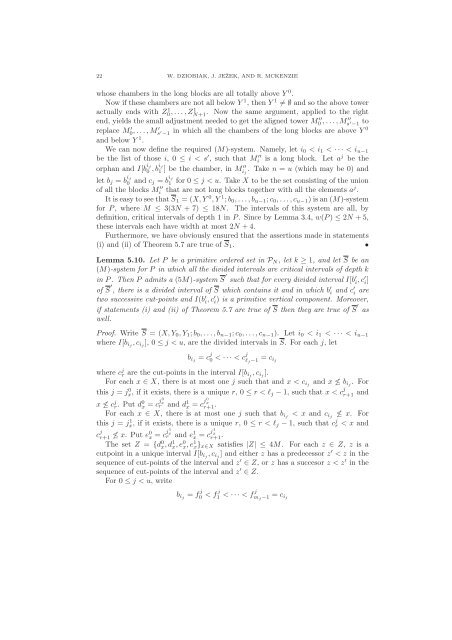Avoidable structures, II: finite distributive lattices and nicely ...
Avoidable structures, II: finite distributive lattices and nicely ...
Avoidable structures, II: finite distributive lattices and nicely ...
Create successful ePaper yourself
Turn your PDF publications into a flip-book with our unique Google optimized e-Paper software.
22 W. DZIOBIAK, J. JEŽEK, AND R. MCKENZIE<br />
whose chambers in the long blocks are all totally above Y 0 .<br />
Now if these chambers are not all below Y 1 , then Y 1 ≠ ∅ <strong>and</strong> so the above tower<br />
actually ends with Z0,...,Z 1 N+1 1 . Now the same argument, applied to the right<br />
end, yields the small adjustment needed to get the aligned tower M 0,...,M ′′<br />
s ′′ ′ −1 to<br />
replace M 0,...,M ′ s ′ 0<br />
′ −1 in which all the chambers of the long blocks are above Y<br />
<strong>and</strong> below Y 1 .<br />
We can now define the required (M)-system. Namely, let i 0 < i 1 < ··· < i u−1<br />
be the list of those i, 0 ≤ i < s ′ , such that M i ′′ is a long block. Let a j be the<br />
orphan <strong>and</strong> I[b ij<br />
0 ,bij 1 ] be the chamber, in M′′ i j<br />
. Take n = u (which may be 0) <strong>and</strong><br />
let b j = b ij<br />
0 <strong>and</strong> c j = b ij<br />
1 for 0 ≤ j < u. Take X to be the set consisting of the union<br />
of all the blocks M i ′′ that are not long blocks together with all the elements a j .<br />
ItiseasytoseethatS 1 = (X,Y 0 ,Y 1 ;b 0 ,...,b u−1 ;c 0 ,...,c u−1 )isan(M)-system<br />
for P, where M ≤ 3(3N + 7) ≤ 18N. The intervals of this system are all, by<br />
definition, critical intervals of depth 1 in P. Since by Lemma 3.4, w(P) ≤ 2N +5,<br />
these intervals each have width at most 2N +4.<br />
Furthermore, we have obviously ensured that the assertions made in statements<br />
(i) <strong>and</strong> (ii) of Theorem 5.7 are true of S 1 .<br />
•<br />
Lemma 5.10. Let P be a primitive ordered set in P N , let k ≥ 1, <strong>and</strong> let S be an<br />
(M)-system for P in which all the divided intervals are critical intervals of depth k<br />
in P. Then P admits a (5M)-system S ′ such that for every divided interval I[b ′ i ,c′ i ]<br />
of S ′ , there is a divided interval of S which contains it <strong>and</strong> in which b ′ i <strong>and</strong> c′ i are<br />
two successive cut-points <strong>and</strong> I(b ′ i ,c′ i ) is a primitive vertical component. Moreover,<br />
if statements (i) <strong>and</strong> (ii) of Theorem 5.7 are true of S then they are true of S ′ as<br />
well.<br />
Proof. Write S = (X,Y 0 ,Y 1 ;b 0 ,...,b n−1 ;c 0 ,...,c n−1 ). Let i 0 < i 1 < ··· < i u−1<br />
where I[b ij ,c ij ], 0 ≤ j < u, are the divided intervals in S. For each j, let<br />
b ij = c j 0 < ··· < cj l j−1 = c i j<br />
where c j r are the cut-points in the interval I[b ij ,c ij ].<br />
For each x ∈ X, there is at most one j such that <strong>and</strong> x < c ij <strong>and</strong> x ≰ b ij . For<br />
this j = j 0 x, if it exists, there is a unique r, 0 ≤ r < l j −1, such that x < c j r+1 <strong>and</strong><br />
x ≰ c j r. Put d 0 x = c j0 x r <strong>and</strong> d 1 x = c j0 x<br />
r+1 .<br />
For each x ∈ X, there is at most one j such that b ij < x <strong>and</strong> c ij ≰ x. For<br />
this j = j 1 x, if it exists, there is a unique r, 0 ≤ r < l j −1, such that c j r < x <strong>and</strong><br />
c j r+1 ≰ x. Put e0 x = c j1 x r <strong>and</strong> e 1 x = c j1 x<br />
r+1 .<br />
The set Z = {d 0 x,d 1 x,e 0 x,e 1 x} x∈X satisfies |Z| ≤ 4M. For each z ∈ Z, z is a<br />
cutpoint in a unique interval I[b ij ,c ij ] <strong>and</strong> either z has a predecessor z ′ < z in the<br />
sequence of cut-points of the interval <strong>and</strong> z ′ ∈ Z, or z has a succesor z < z ′ in the<br />
sequence of cut-points of the interval <strong>and</strong> z ′ ∈ Z.<br />
For 0 ≤ j < u, write<br />
b ij = f j 0 < fj 1 < ··· < fj m j−1 = c i j
















